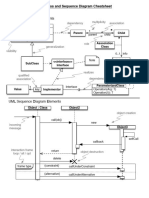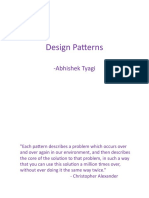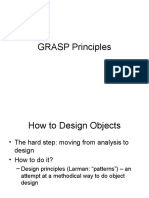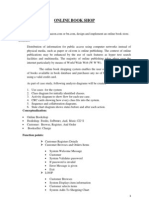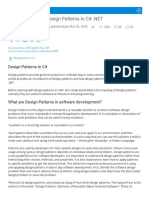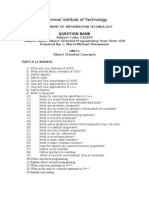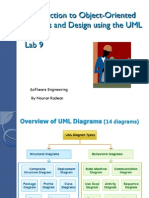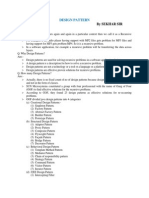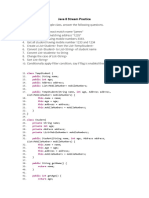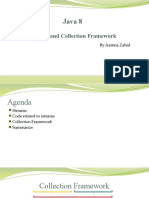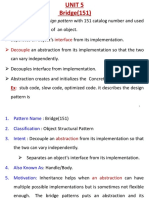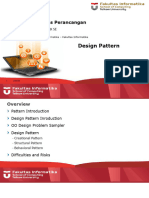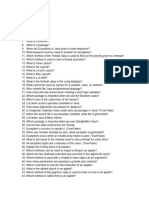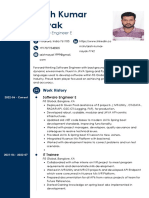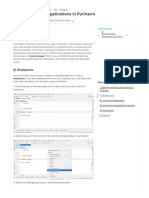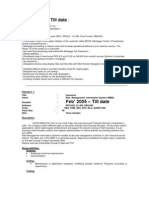OO Design Patterns
Ref: Design Patterns, Elements of Reusable Object-Oriented Software by Gamma, Helm, Johnson, & Vlissides
[aka The Gang of Four]
Why Design Patterns?
A mature engineering discipline codies its experience:
Addison-Welsley, 1995. Basic idea: Reusable metaphors for designing OO software systems.
[But not all patterns are truly OO.]
When confronted with endless possibilities, rely on those who have gone before you:
CS211 ooDesignPatterns
I highly recommend you buy and read this book.
[Easy to read a few pages at a time.]
When this book came out, it caused a lot of excitement: Resonance with professional software developers. Oh yeah, Ive seen that before. We call it XXX in our group. Put into writing a lot of shared knowledge. Some people complained: Whats the big deal? Everyone knows that! Book describes 23 patterns: name and description abstract representation examples (high-level and code-level) applicability and usefulness
We software professionals have done a poor job of writing down what weve learned.
CS211 ooDesignPatterns
There are thousands of patterns out there and thousands more waiting to be discovered: Some are domain specic. Some are a lot like others, special cases, etc. There is no ocial person or group who decides what is/isnt a design pattern: many DP web pages newsgroups discussions more books academic conferences special term: patterns geek
CS211 ooDesignPatterns
trade os, caveats, experiences, relative (dis)advantages relationship to other patterns
but this list isnt meant to be the last word
CS211 ooDesignPatterns
What Use Are Design Patterns?
communicate about systems with other developers give guidance in resolving non-functional requirements and trade-os: portability extensibility maintainability, re-usability, scalability avoid known traps, pitfalls, and temptations ease restructuring, refactoring coherent, directed system evolution and maintenance
Think of as a low-level software architecture or a high-level programming abstraction. First, you learn the basics (data structures, algorithms, tool and lang details). Then, you learn modules/interfaces/information hiding, classes/OO programming. Design patterns are at the next level of abstraction: read, read, read, think, think, think, apply!
[How do chess players become world class?]
Design patterns help you: design new systems using higher-level abstractions than variables, procedures, and classes. understand relative tradeos, appropriateness, (dis)advantages of patterns understand essence of what youre constructing
CS211 ooDesignPatterns
CS211 ooDesignPatterns
Graphical Notation
[similar to Rumbaughs OMT]
className methodSig(); a class (with methods and vars)
The Adapter Pattern
Intent: Convert the interface of a class into another interface clients expect. Adapter lets classes work together that couldnt otherwise because of incompatible interfaces. Motivation:
ItalicClassName means abstract
dataSig;
A class B inherits from class A or class B implements abstract class A B
A class B instantiates from class A B
methodSig();
methodImpl()
CS211 ooDesignPatterns
object
an object
object objectRef anotherObject
When we want to reuse classes in an application that expects classes with a dierent and incompatible interface, we do not want to (and often cannot) change the reusable classes to suit our application.
CS211 ooDesignPatterns
�
Example of the Adapter Pattern
Editor Shape BoundingBox() CreateManipulator() TextView
GetExtent() text
TextShape
BoundingBox() CreateManipulator() return text -> GetExtent() return new TextManipulator
Structure of the Adapter Pattern
Client
Target Request()
Adaptee
SpecificRequest()
(implementation)
Adapter
Request() SpecificRequest()
Using Multiple Inheritance
LineShape
BoundingBox() CreateManipulator()
Client
Target Request()
Adaptee
SpecificRequest()
CS211 ooDesignPatterns
adaptee
Adapter
Request() adaptee -> SpecificRequest()
Using Object Composition
CS211 ooDesignPatterns
10
Participants of the Adapter Pattern
Target: Denes the application-specic interface that clients use. Client: Collaborates with objects conforming to the target interface. Adaptee: Denes an existing interface that needs adapting. Adapter: Adapts the interface of the adaptee to the target interface.
Class- vs. Object-level Adapter
Class-level (might) require real MI all trad. MI problems Is Is-a the right relationship? Object-level makes for messy interface/wrapping (but can be selective): extra syntax, wrapping how much adapting will you do? lose polymorphism
CS211 ooDesignPatterns
11
CS211 ooDesignPatterns
12
�
Intent:
The Bridge Pattern
Xwindow
But sometimes, we want a hierarchy for A on its own, independent of these concrete classes:
Window
Decouple an abstraction from its implementation so the two can vary independently. Motivation: Usually, when an abstraction has several possible implementations, use an abstract base class with several concrete derived classes:
AbsClass
MSwindow
IconWindow
TransientWindow
IconXwindow
IconMSwindow
TransientXwindow
Could add ag to all Windows
Window::WindowKind enum {X, Win, MacOS};
and add switch statement to all routines, ... but this defeats OO programming and polymorphism!
CS211 ooDesignPatterns
13
The basic problem is that we have two dimensions: 1. Abstract windows i.e., Window, IconWindow, TransientWindow 2. Window implementations i.e., X, MS, MacOS Bridge solution: use two inheritance hierarchies and add a level of indirection.
Bridge
Window
DrawText() DrawRect() impl
Bridge
Lots of code duplication
[cloning, not good reuse]
less maintainable
CS211 ooDesignPatterns
14
Structure of the Bridge Pattern
Abstraction
Operation()
impl
Implementor
OperationImpl()
impl -> OpImpl()
WindowImpl
DevDrawText() DevDrawLIne()
RefinedAbstraction
ConcreteImplementorA
OperationImpl()
ConcreteImplementorB
OperationImpl()
CS211 ooDesignPatterns
impl->DevDrawLine() impl->DevDrawLine() impl->DevDrawLine() impl->DevDrawLine()
TransientWindow
IconWindow
DrawCloseBox()
XWindowImp
DevDrawText() DevDrawLine()
MSWindowImp
DevDrawText() DevDrawLine()
DrawBorder()
DrawRect() DrawText()
DrawRect()
XDrawLine()
XDrawString()
15
CS211 ooDesignPatterns
16
Participants
Abstraction (Window) denes interface of abstraction maintains a reference to an object of Implementor RenedAbstraction (Icon Window) extends interface of Abstraction Implementor (WindowImpl) denes interface for implementation classes often quite dierent from Abstraction usually denes primitives which Abstraction combines usefully
The Composite Pattern
Intent: Compose objects into tree structures to represent part-whole hierarchies. Composite lets clients treat individual objects and compositions of objects uniformly. Motivation: If pattern not used, clients must treat primitives and containers dierently.
CS211 ooDesignPatterns
Line
Draw()
ConcreteImplementor (XWindowImpl) implements primitives dened in Implementor
17
Usually, clients shouldnt need to know if object is primitive or composite.
CS211 ooDesignPatterns
18
Example of the Composite Pattern
Structure of the Composite Pattern
Graphic Draw()
Client Component Operation()
graphics
children
Rect.
Draw()
Text
Draw()
GraphicContainer
Draw() Add(Graphic) Remove(Graphic) GetChild(int) forall g in graphics g.Draw()
Leaf
Operation()
Leaf
Operation()
ComponentContainer
Operation() Add(Component) Remove(Component) GetChild(int) forall g in children g.Operation()
CS211 ooDesignPatterns
Picture
Draw() Add(Graphic) Remove(Graphic) GetChild(int)
19
ConcreteCompContainer1
Operation() Add(Component) Remove(Component) GetChild(int)
ConcreteCompContainer2
Operation() Add(Component) Remove(Component) GetChild(int)
CS211 ooDesignPatterns
20
�
Notes on the Composite Pattern
Gamma et al. think that the management routines should be declared at the top level, even if leaves (e.g., Rectangle) have no use for them their motivation is transparency: only one interface which everyone implements. This is WRONG OO-wise. If you use a second interface (i.e., Container), can still use the Graphic interface most of the time
Participants of Composite Pattern
Component (Graphic) Declares the interface for objects in the composition. Implements default behavior for the interface common to all classes. BUT should NOT declare an interface for accessing and managing its child components (Gamma et al. says it should) Leaf (Rectangle) Represents leaf objects in the composition. A leaf has no children. denes behavior for primitive objects in the composition.
CS211 ooDesignPatterns
Client
Why did they do this? Confusion of C++ RTTI with proper dynamic type information. This is completely safe in Java.
21
CS211 ooDesignPatterns
22
The Facade Pattern
ComponentContainer (GraphicContainer ) Denes interface for components having children. Stores child components. Implements some child-related operations in the component interface; defers others to its derived classes ConcreteCompContainer (Picture) Denes remaining behavior (for components having children) not dened by ComponentContainer.
Intent: Provide a single, unied interface to a set of interface/modules in a subsystem. Abstracts a whole subsystem into one interface. Motivation: Reduce complexity of a system. Increase cohesion within a subsystem and reduce coupling with other parts of the system.
CS211 ooDesignPatterns
Manipulates objects in the composition through the component interface.
23
Fewer, simpler, interactions within system Easier to use, reuse Easier to replace components.
CS211 ooDesignPatterns
24
Example of the Facade Pattern
Structure of the Facade Pattern
Compiler Compile() Scanner CodeGenerator Parser Token
Client Classes
Facade
ProgNodeBuilder RISCCG ProgNode StackMachineCG
StatementNode
CS211 ooDesignPatterns
ExpressionNode VariableNode
Compiler Subsystem Classes
25
Another Example of the Facade Pattern
Subsystem Classes
CS211 ooDesignPatterns
26
Participants of the Facade Pattern
Facade (Compiler)
MINITUNIS
USER_SYS
main Control Family User State
Knows which subsystem classes are responsible for a request. Delegates client requests to appropriate subsystem objects. Subsystem still does the work; facade just directs trac. Subsystem Classes (Other SS components)
FILE_SYS
File Directory FileTable Computer Memory
INODE_SYS
Inode InodeTable FileIO FreeInode InodeGlobals Disk DiskMutex
DEVICE_SYS
DeviceDriver Tty
Implement subsystem functionality.
CS211 ooDesignPatterns
GLOBALS
System Panic
27
Handle work assigned by the facade object. Have no knowledge of the facade; that is, they keep no references to it.
CS211 ooDesignPatterns
28
�
Intent:
The Mediator Pattern
An Object-Level Example
aListBox aClient
director director
aFontDialogDirector aButton
director
Dene an object that encapsulates how a set of objects interact, rather than having the objects refer to each other explicitly. Motivation: Simpler model; components send messages to the manager who decides how to reroute them. Easier to evolve components, less special knowledge scattered around subsystem
anotherButton
director
CS211 ooDesignPatterns
Allows for dierent kinds of dependencies/communication between components.
29
CS211 ooDesignPatterns
30
A Class-Level Example
Structure: Object-Level
DialogDirector
ShowDialog() CreateWidget() WidgetsChanged(Widget)
director
Widget
Changed()
aColleague aColleague
mediator
director->WidgetsChanged(this)
mediator
aConcreteMediator
ListBox
GetSelection()
EntryField
SetText()
FontDialogDirector
CreateWidget() WidgetsChanged(Widget)
list
aColleague
mediator
field
aColleague
mediator
CS211 ooDesignPatterns
31
CS211 ooDesignPatterns
32
�
Structure: Class-Level
Mediator
mediator
Participants of the Mediator Pattern
Mediator (DialogDirector) denes an interface for communicating with colleague observers ConcreteMediator (FontDialogDirector) implements co-operative behaviour by co-ordinating Colleague objects
ConcreteColleague1 ConcreteColleague2
Colleague
knows and maintains its list of colleagues Colleague classes (Listbox)
ConcreteMediator
CS211 ooDesignPatterns
33
each colleague knows who its mediator object is each colleague communicates with its mediator when it wants to send messages
CS211 ooDesignPatterns
34
The Observer Pattern
Most appropriate when:
Intent: Dene a one-to-many dependency between objects so that when one object changes state, all its dependents are notied and updated automatically. Motivation:
(Dis)Advantages:
A common side-eect of partitioning a system into a collection of cooperating classes is the need to maintain consistency between related objects.
CS211 ooDesignPatterns
35
You dont want to achieve consistency by making the classes tightly coupled, because that reduces their re-usability.
CS211 ooDesignPatterns
36
�
Example of the Observer Pattern
a x y z b c a a b c b c
60 30 10 50 30 20 80 10 10
Subject
Attach(Observer) Detach(Observer) Notify()
Structure of the Observer Pattern
The key objects in this pattern are subject and observer. A subject may have any number of dependent observers. All observers are notied whenever the subject undergoes a change in state.
observers
Observer Update()
a = 50% b = 30% c = 20%
for all o in observers { o -> Update() }
CS211 ooDesignPatterns
change notification
requests, modifications
37
Participants of the Observer Pattern
GetState() SetState() subjectState
ConcreteObserver
Update() subject return subjectState observerState observerState = subject->GetState()
ConcreteSubject
CS211 ooDesignPatterns
38
When to use the observer pattern:
Subject Knows its numerous observers. Provides an interface for attaching and detaching observer objects. Sends a notication to its observers when its state changes. Observer Denes an updating interface for concrete observers. ConcreteSubject Stores state of interest to concrete observers. ConcreteObserver lets you vary subject and observer independently decouples structure between objects when a change to one object requires changes to others, but you dont know (or ought to know) which ones those are when an the objects should not be tightly coupled
Notes:
after being informed of a change, Observer may query subject for more information
CS211 ooDesignPatterns
Maintains a reference to a concrete subject object. Stores state that should stay consistent with the subjects. Implements the updating interface.
39
can use abstract classes for Subject and Observer more exible, easier variation and composition ...
CS211 ooDesignPatterns
40
There are two basic models of updating: 1. push all observers notied whether they want the information or not
Flyweight Pattern
Intent: Use sharing to support large numbers of nely-grained objects eciently. Motivation: Some applications use lots of nely-grained (i.e., little) objects. BUT objects entail overhead (wrapping). If LOTS of such objects are required AND if such objects are really values at heart, then make a single pool of these objects for everyone to share.
2. pull subjects are sent little or no information (There has been a change; contact me for more details.) Might not want to push all of the information around to all observers: Not all objects need or ought to know everything. Message passing takes time, space, overhead. Some changes are undone or superuous
CS211 ooDesignPatterns
Subjects may register for only some kinds of information Have to specialize kinds of messages, more detail to manage.
41
Examples of the Flyweight Pattern
Java scalar wrapper classes (e.g., Integer) + GC Java Strings + GC Word processing system would like to treat all entities as objects for sake of system uniformity, even chars Solution: Treat chars as object-values Global pool of constant objects; likely stored in a table of some kind for look up, but clients can link to these objects directly. only one object instantiated to represent, say, letter m. All uses of m are links to the global object representing this letter. each letter-object represents a constant value rather than an interesting independent object with mutable state.
CS211 ooDesignPatterns
42
Round and round the ragged rock the ragged rascal ran (apparently with no ill effects from the DDT on the grass). She sells sea shells by the sea shore; however, failure to disclose such earnings is a direct violation of federal income tax laws. Dont try this at home.
User text
row object
character object references
Representation
CS211 ooDesignPatterns
43
Letter Object Pool
a b k u
d n x
e o y
f p z
h i s
j t
character objects
l m v w
q r
CS211 ooDesignPatterns
44
�
Glyph
Draw (Context) Intersects (Point, context)
children children
Row Character
Draw (Context) Intersects (Point, context) char c
Column
Draw (Context) Intersects (Point, context)
Draw (Context) Intersects (Point, context)
Could have separate object pool for each font family, pass in locations, size, slant, text colour to drawChar Allows for exible font family hierarchies rather than monolithic character class Call yweight because each object stores minimal information about its state
Notes:
letter-objects cannot (easily) have back references to the containing object When it comes time to draw the character, will have to pass in appropriate context that would normally be part of the object state e.g., (x, y ) screen locations, font information, text colour
CS211 ooDesignPatterns
45
CS211 ooDesignPatterns
46
Structure of the Flyweight Pattern
Participants of the Flyweight Pattern
Flyweight (Glyph)
FlyweightFactory
getFlyweight(key)
flyweights
Flyweight
Operation (extrinsicState)
ConcreteFlyweight1
Operation (extrinsicState) intrinsicState
ConcreteFlyweight2
Operation (extrinsicState) intrinsicState
declares an interface through which yweights can receive and act on extrinsic state Concrete Flyweight (Character) implements the Flyweight interface and adds storage for intrinsic state (if any).
Client
CS211 ooDesignPatterns
if (flyweight[key] exits) { return existing flyweight } else { create new flyweight add it to the pool return a ref. to it }
47
An instance of this class must be sharable Any state it stores must be intrinsic
CS211 ooDesignPatterns
48
�
Flyweight Factory creates and manages Flyweight objects as needed might create all yweight objects at start or just as needed Client maintains references to yweights computes/stores extrinsic state of yweight objects
Applicability of Flyweight Pattern
All of the following should be true: Applications uses LARGE number of objects most object state can be made extrinsic practically proliferation of objects will be greatly reduced by using a shared pool (non-extrinsic) object identity doesnt matter
ensures sharing is done properly, provides (and sometimes creates) instances as requested
CS211 ooDesignPatterns
49
CS211 ooDesignPatterns
50
Notes on Flyweights
creation may be done once at initialization or as needed on the y need to manage context (extrinsic state) separately from the objects This is unnatural and awkward! Watch out for errors, funny assumptions, odd glue commonly done to manage system resources
Consider how Java handles strings:
String instances are immutable once created
[Use StringBuffer for mutable strings] String s1, s2; s1 = "hello"; s2 = "hello"; if (s1 == s2) { ...
% Probably wrong
[You probably meant to say if (s1.equals(s2))]
Also, all Java scalars have corresponding wrapper classes (e.g., Integer.
CS211 ooDesignPatterns
e.g., system fonts, colour maps
51
CS211 ooDesignPatterns
52
�
Intent:
The Iterator Pattern
How its done in various programming languages: Lisp-y functional languages provide mapcar-like function to do this. Pass in a function as an argument. C/C++ allow function-as-arguments, but C++ also provides an iterator class in the STL Java does not allow function-as-arguments, but does an iterator construct called an Enumeration.
Provide a clean, abstract way to access all of the elements in an aggregate (container) without exposing the underlying representation. Also, moves responsibility for access and traversal to a separate iterator object.
Motivation:
Often want to say to a container (e.g., tree, graph, table, list, graphic), Apply f() to each of your objects. . Dont want to expose implementation details of the container AND want to allow multiple simultaneous traversals Create separate interface/class that provides simple hooks.
CS211 ooDesignPatterns
53
CS211 ooDesignPatterns
54
Example in Java Java Enumerations
java.util.Enumeration is an interface that may be implemented by any class.
public interface Enumeration public abstract boolean hasMoreElements(); public abstract Object nextElement(); class CardPlayer { ... // CardPile extends java.util.Vector CardPile tricks; // Count up how many points Ive earned in // my tricks this round and add it to my // running total. public void countAndAddPoints () { int numPointsThisRound = 0; Enumeration tricksEnum = tricks.elements(); while (tricksEnum.hasMoreElements()) { Card c = (Card) tricksEnum.nextElement(); numPointsThisRound += c.value(); } points += numPointsThisRound; }
java.util.Vector (array with resizable bounds) denes a method called elements that returns an enumeration of the vector.
CS211 ooDesignPatterns
public class Vector public final synchronized Enumeration elements();
55
CS211 ooDesignPatterns
56
�
Structure of the Iterator Pattern
list
List ListIterator
First() Next() IsDone() CurrentItem() index
Participants of the Iterator Pattern
Iterator Denes an interface for accessing and traversing elements. ConcreteIterator Implements an iterator interface. Keeps track of the current position in the traversal of the aggregate. Aggregate Denes an interface for creating an iterator object.
Count() Append(Element) Remove(Element)
...
CS211 ooDesignPatterns
57
ConcreteAggregate Implements the iterator creation interface to return an instance of the proper concrete iterator.
CS211 ooDesignPatterns
58
Notes on the Iterator Pattern
The iterator interface basically provides two hooks: Next, please. All done? Can provide a few others hooks too (how many left, go back, start over, etc.) Can dene dierent iterator implementation that redene what next element means.
Can have multiple iterations ongoing simultaneously (enumerator state basically consists how far along it is in the list). Of course, if you change (or allow others to change) the aggregate (add/remove) or its contained objects, then chaos may result! May therefore want to lock out changes during an iteration (concurrency control) iterator may take fast snapshot of aggregate state and use that to iterate through may want to buer requested changes while an iterator is active, then commit
CS211 ooDesignPatterns
walk through a tree, alphabetical order, LRU
59
Complicated structures may be dicult to iterate through Store path taken or nodes visited
CS211 ooDesignPatterns
60
The Template Method Pattern
};
Example (Cargill again)
Intent: Dene the skeleton of an algorithm in an operation, deferring some steps to subclasses. Template Method lets subclasses redene certain steps of an algorithm without changing the algorithms structure. Motivation: By dening some of the steps of an algorithm using abstract operations, the template method xes their ordering.
class Vehicle { private: char *plate; protected: virtual char *group () = 0; public: Vehicle () {plate=NULL;} Vehicle (char *p) { plate = new char [strlen(p)+1]; strcpy (plate, p); } virtual ~Vehicle () {delete [] plate;} virtual void identify () { char *p = plate ? plate : "<none>"; printf ("%s with plate %s\n", group(), p); }
CS211 ooDesignPatterns
Provide the skeleton of a method, where parts are dened/overridden by derived classes.
Typically, do NOT override the template method itself.
61
// Define similarly for Truck class Car : public Vehicle { private: char *group () {return "Car";}; public: Car () : Vehicle () {} Car (char *p) : Vehicle (p) {} };
CS211 ooDesignPatterns
62
Participants of the Template Pattern Structure of the Template Method Pattern
AbstractClass (Vehicle) Denes abstract primitive operations that concrete subclasses dene to implement steps of an algorithm. Implements a template method dening the skeleton of an algorithm. The template method calls primitive operations as well as operations dened in AbstractClass or those of other objects. ConcreteClass (Car, Truck)
AbstractClass
TemplateMethod()
...
PrimitiveOp1()
... ...
PrimitiveOp1() PrimitiveOp2()
PrimitiveOp2()
ConcreteClass
CS211 ooDesignPatterns
PrimitiveOp1() PrimitiveOp2()
63
Implements the primitive operations to carry out subclass-specic steps to the algorithm.
CS211 ooDesignPatterns
64
�
Notes on the Template Method Pattern
Very common to have in abstract base classes, esp. libraries intended for reuse and customization. A kind of polymorphism (think about it) practised within a class hierarchy. Whatever object I turn out to be, use my denition on primitiveOp(), then print, ... This is a common pattern to recognize during secondary passes at design.
Intent:
The Memento Pattern
Without violating encapsulation, capture and externalize an objects internal state so that the object can be restored to this state later. Motivation: Often want to be able to take snapshots of an objects current state in case: want to unroll changes debugging store sequence of abstract transactions by class that is not privy to underlying representation of transaction.
CS211 ooDesignPatterns
state
Refactor commonalities into the parent class; push as much as possible as high as possible.
65
BUT dont want to break encapsulation/information hiding state type must be opaque
CS211 ooDesignPatterns
66
Participants of the Memento Pattern
Memento
Structure of the Memento Pattern
memento
Originator
SetMemento (Memento m) CreateMemento()
Memento
GetState() SetState() state
Caretaker
Stores internal state of the Originator object. The memento may store as much or as little of the originators internal state as necessary at its originators discretion. Protects against unwanted access by objects other than the Originator. Eectively has two interfaces: narrow and wide Originator
return new Memento (state);
state = m->getState();
CS211 ooDesignPatterns
67
Creates a memento containing a snapshot of its current internal state. Uses the memento to restore its internal state.
CS211 ooDesignPatterns
68
�
Caretaker is responsible for the mementos safekeeping. never directly operates on or examines the contents of a memento.
Notes on the Memento Pattern
Simplies Originator as others may now maintain collections of state, albeit without being able to look under the hood Dont forget TNSTAAFL Temptation to store all states for unlimited undo BUT dont forget that everything takes storage.
[Did you keep every mail message you ever received?]
CS211 ooDesignPatterns
69
Design Patterns Summary
CS211 ooDesignPatterns
70
Intended to provide a common: vocabulary for inter-developer communication. set of abstract building blocks for system designers set of patterns to look for when refactoring / redesigning / reverse engineering existing systems. Not exclusively OO, despite the book title; really based on encapsulation and interacting objects. Seems particularly useful for concurrent/distributed systems where logic is hard to get right and possibilities are too numerous. Early days yet, but many are very excited.
CS211 ooDesignPatterns
71

